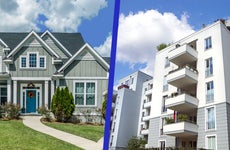Guide to multi-family home investing

The Bankrate promise
At Bankrate we strive to help you make smarter financial decisions. While we adhere to strict , this post may contain references to products from our partners. Here's an explanation for .
So you’re thinking about investing in real estate. Whether you’re dreaming of becoming the next real estate tycoon or just want a duplex to help pay your mortgage, there are many compelling reasons why you may want to target a particular type of property: the multi-family home.
As the name implies, multi-family homes house more than one group of people within one building or complex (as opposed to a single-family dwelling). They offer a lot of potential for income and property appreciation, but there’s also more responsibility and risk
Let’s break down how investing in multi-family homes works, and the pros and cons.
What are multi-family homes?
Multi-family homes consist of multiple, separate housing units under the same roof or complex. Each unit has a unique address with an entrance and living areas separate from the others. There are many different households/tenants, but only one building owner — which could be an individual or a corporate entity.
According to the latest U.S. Census Bureau data, multi-family homes represent more than 30 percent of housing in the U.S., so there’s a lot of potential for growth — and opportunities investment. For the investor, these types of homes are income-generators, offering steady cash flow from the rents the tenants pay. There’s also the potential for the real estate to appreciate in value over the years.
Types of multi-family homes
Multi-family homes come in a wide variety, with the number of units ranging from two to 2,000. The different types of multi-family homes you can invest in include:
- Duplexes, triplexes, and fourplexes. These properties have two, three or four units, respectively. You may be able to “house hack” this type of property by living in one unit and renting out the others. Often, these qualify for regular mortgages or owner-occupied financing.
- Apartments. Apartment buildings have multiple units and are owned by a single entity. Management is typically onsite. You’ll need a commercial loan to finance this type of property.
- Condominiums. Condos often resemble apartments, though they can also take the form of town- or rowhouses. Unlike apartments, which tend to be rentals, condos are owned individually, though common spaces are shared and managed by a homeowner’s association (made up of the condo residents).
- Mixed-Use. A mixed-use multi-family unit combines housing with retail, commercial, entertainment, or cultural spaces.
- Student Housing. Built near universities, these complexes are designed to serve the needs of students.
- Age-Restricted. Typically, these types of multi-family homes restrict occupancy to those aged 55 and older. Buildings, amenities, features, and activities are geared towards those in this age group.
- Income-Restricted. Subsidized housing helps those on a lower income be able to afford a home. The federal government often works with developers to build these units. You may be able to accept federal housing choice vouchers if you invest in this type of property.
Investing in multi-family homes
Investing in multi-family properties — known as multi-family investing — is not for the weak, nor is it passive. It’s a lot of work and there are some major things you’ll need to consider before sinking your hard-earned cash into a multi-family property.
One key thing to know, first off: Multi-family homes can be considered either residential or commercial real estate. Smaller multi-family homes, those with four or fewer units, are classified as residential property; commercial multi-family property has five or more units. The difference can be significant when it comes to financing.
How to finance a multi-family property
Financing a multi-family property depends on how many units there are in the property you’re buying .
For four units or less, you may be able to finance the property as a single-family home with a conventional loan. This means the mortgage-market-makers Fannie Mae and Freddie Mac will back, and may eventually buy, the loan, which ultimately makes it less expensive for lenders to offer. You may also be able to finance it with an FHA loan, which means you can put less money down than the conventional 20 percent most private lenders require.
If the property you want to buy has five or more units, you’ll need a commercial loan, however. Commercial mortgages have different terms than residential mortgages do. They tend to run shorter, for one thing. Also, the lender will consider the projected income from rents in factoring how much they’re willing to lend you, as well the interest rates they’ll offer.
Management
Good management of an investment property is essential. But with multiple units comes a lot more responsibility. While it’ll cut into your profits, you might want to hire a professional property manager to oversee things, and — unless you’re good with your hands — and an onsite superintendent or maintenance staffer. At the very least, you might want an accountant to keep the books.
Insurance and taxes
Multi-family properties will come with higher costs all around – and this includes landlord insurance and property taxes. But while you should be prepared for the higher tax bill, there are also more opportunities to offset taxes with multi-family properties.
“Taxes are another big reason why people should invest in multi-family,” says real estate investor and Tykes CEO Ryan Pineda. “There are opportunities to do cost segregation, bonus depreciation and rezoning to increase the value significantly.”
Zoning regulations
Zoning regulations will determine where properties can be located and what you can do with them. Zoning laws will allow multi-family properties in certain areas of the city and not in others. You’ll also want to keep zoning ordinances in mind if you’re thinking of converting property (such as apartments to condos or commercial property to residential housing).
Reasons to invest in multi-family real estate
Multi-family real estate offers some distinct advantages over other sorts of investment properties.
Generate income
Multi-family properties are designed for cash flow. The space in each unit is used as efficiently as possible to bring in more renters and more profit. They can offer a lot more income than renting out a single-family house.
Build your real estate portfolio more quickly
If you’re looking to become a serious real estate investor, multi-family properties could allow you to accrue a large number of units more efficiently.
“You have the opportunity to invest in bigger deals and acquire more units quickly, making it a lot easier to manage,” says Pineda. “Instead of having to buy and fix up 30 single family homes and handle 30 different loans, you make one purchase of a multi-family property with 30 or even 300 units in one transaction.”
Strategically increase the value of the property
Multi-family property also affords investors the opportunity for capital appreciation, should they ever decide to sell. “Multi-family properties are great investments since the worth of the property is based on how much net operating income you have, not on what the apartment next door sold for,” says Pineda. “You are rewarded for how much money you can make and there are strategic ways to be creative to generate revenue and increase the value of the property, like lowering the vacancy, raising rents or upgrading the property.”
Decrease your cost of living
Investors of multi-family properties with four or fewer units often live in one of the units, which qualifies them for owner-occupied financing (which is similar to a regular residential mortgage and comes with a lower interest rate). And of course, they pay no rent (or pay it to themselves).
Less risk than other investments
Multi-family property usually offers investors stable cash flow and less risk, even during economic downturns. People always need a place to live, after all. Other types of real estate, such as industrial, retail and office space, carry more risk, as recessions affect them more deeply.
Multi-family properties vs single-family properties
If you’re eyeing residential real estate, the big alternative to investing in multi-family properties is investing in single-family homes. Obviously, the multi-family option is more complex than the single-family one, but there are bigger rewards, too.
For example, both types of properties offer tax benefits, such as depreciation, deductions for operating expenses and mortgage interest, and deferral of capital gains. But multi-family properties allow for more sophisticated strategies to accelerate depreciation deductions and defer federal and state income taxes — thus increasing cash flow.
Here’s a look at the pros and cons for each property class.
Single-Family Homes
| Pros | Cons |
|---|---|
| Easier for novice investors | Not as much rental income potential |
| Fewer tenants to manage | Spread-out nature of properties (if more than one house is owned) |
| High potential for appreciation | More competition for properties |
| Loans are easier to get | Potential drain of time in dealing with tenant issues |
| Larger pool of buyers when you’re ready to sell | Income concentrated in one tenant/unit |
| Tenants tend to stay longer |
Multi-Family Homes
| Pros | Cons |
|---|---|
| Greater income potential; steady income stream | Requires more capital to invest |
| Can offer a place to live as well as an investment | Greater maintenance costs/expenses |
| You can qualify for mortgage, build equity with rents collected | Requires a commercial loan (properties with 5+ units) |
| Less competition for properties | May be harder to find purchasers |
| Enhanced tax benefits |
Final word on investing in multi-family homes
Investing in multi-family real estate offers an interesting way to expand your investment portfolio and generate income. But it takes a lot of money and an incredible amount of work. It’s best suited to “experienced investors, for sure,” says John Antretter, a licensed agent with The Agency in New York City. If you’re a novice, “it is better to start small before having multiple tenants to look after. One tenant would not be as overwhelming as being a landlord to many.”
That said, if you have deep pockets and are willing to enlist some professional managerial help, you’ll want to give multi-family housing a serious look.
Related Articles

Second home vs. investment property: Different mortgage requirements and rules


